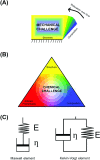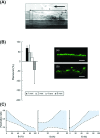Viscoelasticity of biofilms and their recalcitrance to mechanical and chemical challenges
- PMID: 25725015
- PMCID: PMC4398279
- DOI: 10.1093/femsre/fuu008
Viscoelasticity of biofilms and their recalcitrance to mechanical and chemical challenges
Abstract
We summarize different studies describing mechanisms through which bacteria in a biofilm mode of growth resist mechanical and chemical challenges. Acknowledging previous microscopic work describing voids and channels in biofilms that govern a biofilms response to such challenges, we advocate a more quantitative approach that builds on the relation between structure and composition of materials with their viscoelastic properties. Biofilms possess features of both viscoelastic solids and liquids, like skin or blood, and stress relaxation of biofilms has been found to be a corollary of their structure and composition, including the EPS matrix and bacterial interactions. Review of the literature on viscoelastic properties of biofilms in ancient and modern environments as well as of infectious biofilms reveals that the viscoelastic properties of a biofilm relate with antimicrobial penetration in a biofilm. In addition, also the removal of biofilm from surfaces appears governed by the viscoelasticity of a biofilm. Herewith, it is established that the viscoelasticity of biofilms, as a corollary of structure and composition, performs a role in their protection against mechanical and chemical challenges. Pathways are discussed to make biofilms more susceptible to antimicrobials by intervening with their viscoelasticity, as a quantifiable expression of their structure and composition.
Keywords: antimicrobial penetration; biofilm; detachment; extracellular polymeric substances (EPS); structure; viscoelasticity.
© The Author 2015. Published by Oxford University Press on behalf of Federation of European Microbiological Society.
Figures





References
-
- Allison DG. The biofilm matrix. Biofouling. 2003;19:139–50. - PubMed
-
- Arciola CR, Campoccia D, Montanaro L. Detection of biofilm-forming strains of Staphylococcus epidermidis and S. aureus. Expert Rev Mol Diagn. 2002;2:478–84. - PubMed
-
- Aslam S. Effect of antibacterials on biofilms. Am J Infect Control. 2008;36:S175.e9–11. - PubMed
-
- ASM International. ASM Handbook. 10th edn. Vol. 2. Metals Park, OH, USA: ASM International; 1990. Properties & Selection—Nonferrous Alloys & Special-Purpose Materials.
Publication types
MeSH terms
Substances
LinkOut - more resources
Full Text Sources
Other Literature Sources

